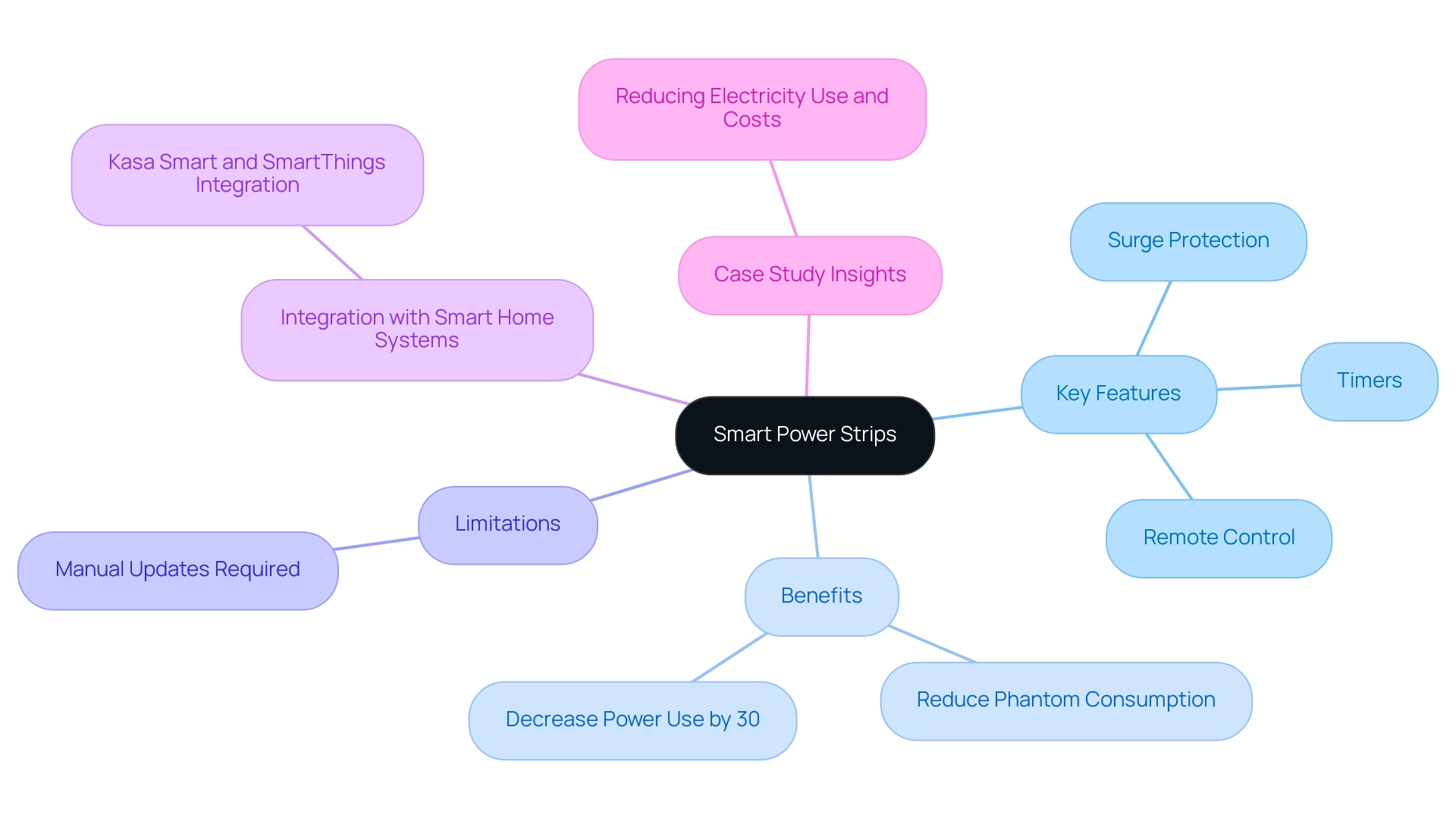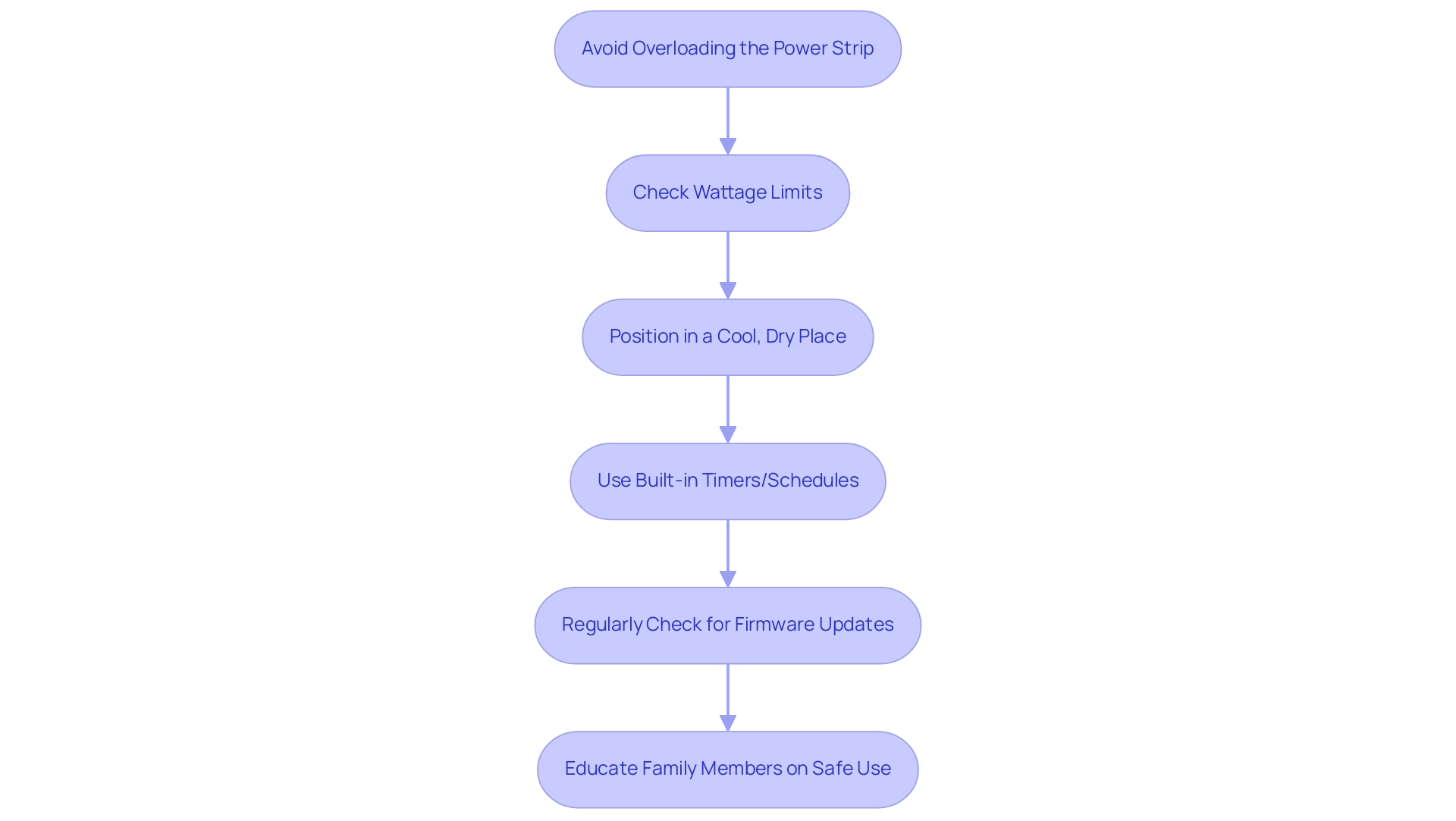Overview
Smart power strips serve as an effective solution for eco-conscious homeowners aiming to reduce electricity consumption and lower utility bills by automatically cutting power to devices in standby mode, potentially saving 10-30% on energy costs. The article supports this by detailing features such as remote control, timers, and energy monitoring, which enhance efficiency and promote sustainable usage habits, while also highlighting their role in minimizing carbon emissions through better resource management.
Introduction
In an age where energy efficiency is paramount, smart power strips emerge as a game-changer in the quest to reduce electricity consumption and promote sustainable practices. These advanced devices not only tackle the pervasive issue of phantom energy use but also empower homeowners with features that enhance control over their electrical devices.
As households increasingly turn to technology for eco-friendly solutions, understanding the functionality, benefits, and best practices associated with smart power strips becomes essential. This article delves into the mechanics of these innovative devices, highlighting their potential to lower energy bills, contribute to environmental sustainability, and offer practical guidance for selection and safe usage.
Understanding Smart Power Strips: Definition and Functionality
Intelligent electrical solutions signify a major improvement in management technology, specifically created to enhance consumption beyond the abilities of conventional models. These innovative devices can automatically cut off electricity from electronics that enter standby mode, effectively combatting ‘phantom’ consumption, which accounts for a substantial portion of household usage. For instance, research has demonstrated that using smart power strips can result in a decrease in power use by as much as 30%, highlighting their effectiveness in handling electrical loads.
However, it’s important to note that smart power strips do not update automatically and require manual updates, which can be a limitation for some users. Many models of smart power strips come equipped with additional features such as:
- Timers
- Remote control capabilities
- Surge protection
These features offer homeowners comprehensive solutions for efficiency. Recent developments, such as the 2019 integration of Kasa Smart from TP Link with SmartThings, highlight the increasing compatibility of these devices within .
This trend highlights the increasing awareness among environmentally aware homeowners of the significance of intelligent electrical devices in minimizing resource waste and enhancing usage in a sustainable way. Moreover, a case study titled ‘Reducing Electricity Use and Costs‘ explores various strategies for decreasing electricity consumption in residences and highlights how energy-efficient practices, including the use of intelligent energy devices, can result in substantial savings on utility bills.
Key Features of Smart Power Strips for Energy Efficiency
are designed with sophisticated features that greatly improve resource management in the household. They frequently incorporate monitoring features that track real-time power usage, enabling homeowners to identify which devices are the largest consumers of power. This insight is invaluable for making informed choices regarding resource use.
Many smart power strips come equipped with multiple outlets that can be individually controlled, allowing users to remotely turn off specific devices through a mobile app. This feature not only offers convenience but is also essential for reducing waste. Moreover, smart power strips often provide timers and scheduling features, allowing individuals to automate energy shut-off during specified hours.
Such automation is particularly effective at reducing unnecessary power consumption, especially from devices that are not in use. For example, a recent case study illustrated the efficiency of smart power strips in decreasing electricity usage from large plug load appliances, such as vending machines and refrigerators, highlighting their capacity to substantially reduce total electricity consumption. Remarkably, North America is presently the leading market for smart power strips, indicating a rising trend towards energy-efficient solutions.
As emphasized by SmartThings, a pioneer in automation and straightforward manufacturing techniques for connected homes, ‘the incorporation of advanced technology into resource management systems is transforming how homeowners address efficiency in their usage.’ This corresponds with the author’s contentment regarding the arrangement for dependable measurements of energy consumption, highlighting the user experience and reliability of these innovative devices.
The Environmental Benefits of Smart Power Strips
The implementation of smart power strips plays a vital role in lowering electricity use, which directly correlates with diminishing carbon emissions. By efficiently controlling standby consumption, homeowners can considerably reduce their yearly usage, resulting in a smaller ecological footprint. Recent statistics show that despite the rise in electric vehicles—over a million new units on the roads in 2023—the U.S. faced a 1.1% decrease in , highlighting the efficiency of advanced technologies in resource management.
Moreover, smart power strips foster more conscious usage habits, motivating families to embrace sustainable practices in their homes. As environmental expert Ahmad Faruqui points out,
The Baltimore Gas and Electric Company (BGE) undertook a dynamic pricing experiment to test customer price responsiveness to different dynamic pricing options.
This experiment demonstrates how consumer behavior can be affected by creative methods, including smart power strips, which assist in managing resource consumption more efficiently.
Additionally, the potential future enhancements for these devices, such as calendar controls and optimization suggestions, could further amplify their impact on reducing carbon emissions, paving the way for a greener future. Furthermore, demand aggregators act as intermediaries between intelligent appliances and electricity markets, facilitating structural impacts that can improve resource management at a broader scale.
How to Select the Best Smart Power Strip for Your Needs
Selecting the appropriate involves several essential factors customized to your power management requirements. First, assess the number of devices you intend to connect, as this will dictate the size and outlet configuration you require. Keep in mind that the EP25, despite being marketed as slim, is comparable in size to standard smart plugs, which is an important factor in your selection.
Prioritize smart power strips that are equipped with monitoring capabilities to effectively track consumption in kilowatt-hours and run time on the device’s home screen, enhancing your ability to manage usage. Surge protection is another crucial feature; as Raimund Koch points out,
A surge protector has additional circuitry to help protect your soundbar or anything that’s plugged in,
which underscores the importance of safeguarding your electronics. In contrast, the Geeni Surge lacks physical buttons and power monitoring, which highlights the importance of these functionalities in your selection process.
Additionally, look for mobile app integration, which allows for remote control and monitoring, ensuring convenience and management over your consumption. A solid warranty and positive reviews are also essential indicators of reliability, promising long-term satisfaction. By choosing smart power strips that align with these features, you can improve your energy efficiency and enhance your home’s management capabilities.
Best Practices for Using Smart Power Strips Safely and Effectively
To maximize the advantages of smart power strips for intelligent energy management while ensuring safety, it is essential to avoid overloading them with too many gadgets, as this can lead to overheating—. Statistics indicate that extension cords are suitable for low-energy devices like lamps and office machinery, and ensuring these devices do not surpass the wattage limit is crucial for safe use. Regularly checking for firmware updates is essential for maintaining optimal functionality and security.
It’s advisable to position strips in a cool, dry location to prevent heat buildup. Using smart power strips that have built-in timers or schedules can further improve resource management by automating consumption, a feature that many homeowners find advantageous. Additionally, educating all family members on the safe use of these smart features is vital, especially considering that children’s natural curiosity can pose dangers related to electricity.
As safety specialist Jane Doe highlights, “Comprehending how to utilize extension cords securely can avert mishaps and guarantee effective resource management.” By adhering to these best practices, homeowners can significantly enhance their resource management through the use of smart power strips while ensuring a safe living environment.
Can Smart Power Strips Help Lower Your Electricity Bills?
Smart power strips are an essential resource for environmentally aware homeowners who want to lower electricity expenses and improve efficiency. By automatically disconnecting electricity to devices that stay in standby mode, smart power strips can lead to considerable savings on monthly utility costs. Financial specialists recommend that users can attain savings of 10-20% on their electricity expenses merely by incorporating smart power strips into their home resource management systems.
Moreover, as homeowners evaluate the expenses of EV chargers, such as that usually vary from $500 to $1,500, and the advantages of solar power, which can greatly reduce electricity expenses, utility companies are encouraging the adoption of these technologies. They provide discounts of $50 to $100 for installing intelligent thermostats, which enhance the use of . A notable case study from the National Renewable Resources Laboratory (NREL) highlights the phenomenon of ‘vampire load,’ where electronic devices consume power even when turned off, which smart power strips can help address, contributing to an additional $200 in yearly costs for the average household.
By replacing conventional electrical units with smart power strips, individuals can tackle this inefficiency; a study conducted by UL Environment found that smart power strips can reduce consumption by up to 48% for those who frequently leave devices on overnight, and by 20% for those who routinely switch off their devices. Furthermore, integrating smart power strips and intelligent plugs can enhance resource management, enabling homeowners to optimize their usage efficiently. In comparing the costs of solar power, which can lower electricity bills significantly over time, to traditional electricity rates, homeowners can make informed decisions about their consumption.
As one specialist clearly stated, ‘Now that you understand how surge protectors can conserve your resources, strategically position them throughout your residence, and begin enjoying the benefits of a more resource-efficient household!’ This makes smart power strips not only an investment in energy efficiency but also a strategic approach towards substantial cost reduction amid increasing energy expenses and the rising interest in solar energy options.
Safety Considerations When Using Smart Power Strips
When choosing smart power strips, it is essential to verify they possess certifications from reputable safety organizations like UL or ETL. These certifications verify that the energy extensions have undergone rigorous testing, minimizing the risks associated with electrical safety. In fact, according to recent statistics, improper use of electrical extensions accounts for approximately 3,000 home fires each year, emphasizing the importance of selecting certified products.
Furthermore, it is recommended to refrain from daisy-chaining multiple electrical units, as this practice can greatly heighten the risk of fire hazards. Consistently checking the state of is crucial; any indications of wear or damage should trigger prompt replacement to ensure safety. Educating family members about the proper use of these devices is also vital in preventing misuse and potential safety risks.
As Jim Folk aptly points out,
By creating and enforcing an electrical outlet policy, the requirement for accessible energy can be fulfilled without losing sight of a health care administration’s mission to protect patients.
This viewpoint emphasizes the wider consequences of using smart power strips in intelligent energy management, aligning operational efficiency with safety protocols. Moreover, the recent conversation regarding hospital-grade electrical devices highlights the necessity for improved safety standards in settings where electrical reliability is essential.
Additionally, Smart Home Energy Management Systems (SHEMS) demonstrate how the integration of smart power strips can facilitate energy savings and enhance safety through user-defined rules and automated device control.
Conclusion
Smart power strips represent a transformative solution for enhancing energy efficiency and sustainability in the modern household. By effectively addressing phantom energy consumption, these devices not only help reduce electricity bills but also contribute significantly to environmental conservation. The advanced features of smart power strips, such as energy monitoring, individual outlet control, and scheduling capabilities, empower homeowners to make informed decisions about their energy use, leading to substantial savings.
Moreover, the environmental benefits of adopting smart power strips are profound. By minimizing energy waste and promoting mindful consumption habits, these devices play a crucial role in lowering carbon emissions. As the market continues to grow, the integration of smart technologies into home energy management systems becomes increasingly essential for fostering a greener future.
Selecting the right smart power strip involves careful consideration of features that align with individual energy management needs, including:
- Surge protection
- Mobile app integration
Prioritizing safety through proper usage and adherence to best practices is equally important to maximize the benefits of these devices.
In conclusion, embracing smart power strips is not just a wise financial decision, but a critical step towards a more sustainable lifestyle. By integrating these innovative devices into homes, individuals can significantly enhance their energy efficiency, lower their utility costs, and contribute positively to the environment. As the adoption of smart power strips continues to rise, the collective impact on energy consumption and sustainability can lead to a brighter, more sustainable future for all.




